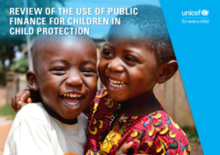Objective:
The purpose of this review is to explore how UNICEF country offices have used Public Finance for Children (PF4C) analyses and interventions within child protection, with a view to learning lessons from their experiences.
As part of its mission to protect and enhance the rights for children, UNICEF works with partner governments to achieve the best possible use of public budgets. This includes the use of public financial analysis, capacity building and advocacy to ensure public funding is adequate, efficient, effective, equitable and transparent, commonly described as Public Finance for Children (PF4C) engagement. Using PF4C analyses can enhance the persuasiveness of advocacy messages for child protection, and contribute to better plans and budgets for scaling-up systems and implementing services. However, child protection is complex, which complicates the process of PF4C-type analyses within the sector.
Child protection covers a wide range of issues impacting on children: violence, abuse and neglect of children, child marriage, female genital mutilation (FGM/C), teenage pregnancies, child labour, child trafficking, sexual violence against and sexual exploitation of children, alternative care for children, adoptions, child poverty, bullying, children in contact/conflict with the law, the incarceration of children, and birth registration (and that is not an exhaustive list). As a result, in each country, a large number of government ministries, departments and agencies (MDAs) are responsible for different aspects of child protection.
So, there is no single ‘budget’ for child protection, but rather allocations are subsumed in various programmes, subprogrammes and activities across the different MDAs. In many countries, the multi-agency nature of child protection is an obstacle to the emergence of coherent, integrated child protection systems, and an even greater obstacle to developing management information systems for child protection (unlike in education and health). This may be further complicated by certain services being decentralized to subnational governments. All of this complicates the use of PF4C tools within child protection, especially the impact on the availability of data. Producing a budget brief becomes a major data collection exercise, costing the provision of services involves multiple ministries, and reviewing the effectiveness of spending is constrained by the lack of performance data.

